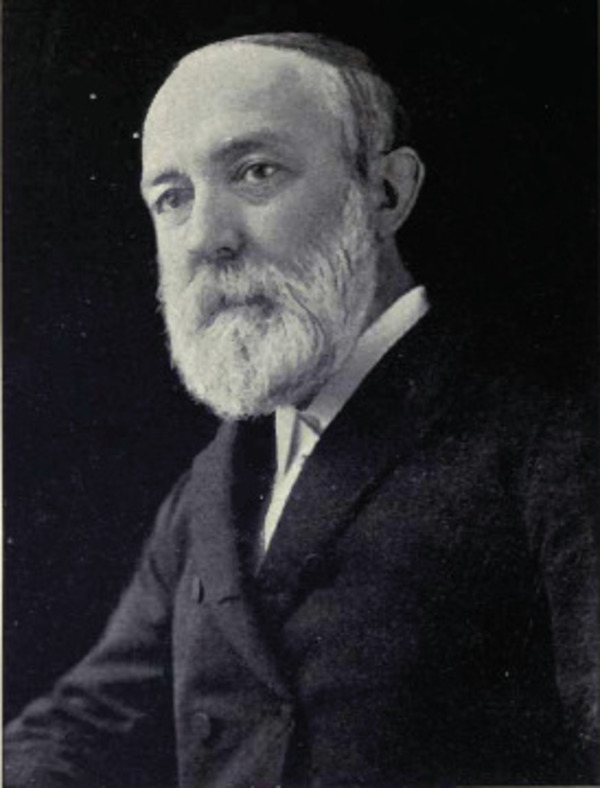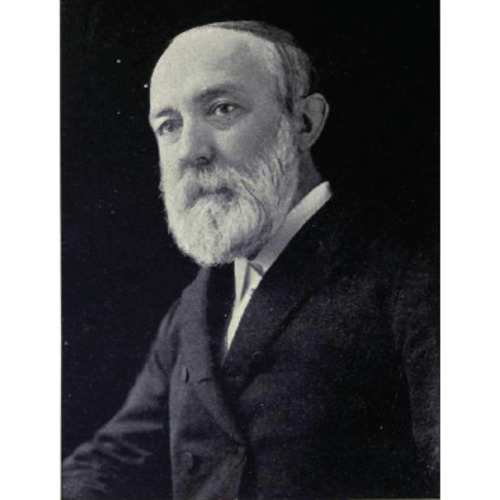
Source: Link
WITHROW, WILLIAM HENRY, Methodist minister, journalist, and author; b. 6 Aug. 1839 in Toronto, son of James Withrow, a contractor, and Ellen Sanderson; m. 1864 Sarah Anne Smith, and they had two sons, one of whom was William James*, and two daughters; d. 12 Nov. 1908 in Toronto.
William Henry Withrow followed his brother John Jacob* at the Toronto Academy before being admitted in February 1857 to Victoria College, Cobourg, where Nathanael Burwash* was a fellow student. Withrow left Victoria in 1859 and spent two years studying architecture. In 1861, however, he decided to enter the ministry of the Canadian Wesleyan Methodist New Connexion Church and was stationed at Waterford. Because of his father’s ill health, he was granted leave in 1862–63. It was evidently this arrangement which enabled him to complete his university education. He received a ba from the University of Toronto in 1863 and an ma in 1864, when he was also ordained. Two years later he transferred to the Wesleyan Methodist Church in Canada, perhaps anticipating that the two churches would unite. In 1868 he was received in full connexion and was appointed to the Davenport and Seaton circuit near Toronto, and in 1873 he became the assistant to the president of the conference, Samuel Dwight Rice*, and editor of the church’s Sunday-school publications.
A class leader in the Metropolitan Church in Toronto, an occasional preacher, and a faithful member of conference, Withrow was always an active participant in the pastoral work of the Methodist Church of Canada, the body that resulted from the union of 1874. His principal roles were, however, as an editor and writer and as an influential figure in the church’s emerging bureaucracy. Here he made a significant contribution to the well-being of his beloved Methodist community and to the development of English-Canadian literary culture.
In 1872 the book committee of the Wesleyan conference had expressed the need for a Methodist magazine in Canada and the suggestion was endorsed in 1874 at the first general conference of the new church. Withrow was appointed editor at a salary of $1,500, and the first issue of the monthly Canadian Methodist Magazine, Devoted to Religion, Literature, and Social Progress, published in Toronto and Halifax, appeared in January 1875. It contained articles on the education of women, exploration in Africa, and current topics, including William Ewart Gladstone’s comments on ritualism (Anglo-Catholicism), as well as poetry, a book review, and religious and missionary news. The first issue’s contents set a pattern that would be followed broadly until the Magazine ceased publication in 1906. Withrow was also a major contributor, as he would continue to be in future. He stated his objectives succinctly: the Magazine was to be “an exponent of the religious and intellectual life of our rapidly extending Church, . . . to furnish wholesome reading for Christian households, and to foster the growth of a sound native literature in our young Dominion. . . . We shall seek also . . . to discuss the religious and social problems, the great living issues of the times . . . from a Christian point of view. . . . We believe, that if adequately sustained, our Magazine may be made a power for good in this land.” In 1883 the Magazine had 2,561 subscribers; in 1902 there were 2,726. Withrow was re-elected editor of the Magazine and of the church’s Sunday school publications by every general conference until his death.
A kindly, tolerant scholar not drawn readily into polemics, Withrow was also a devout Methodist whose education had been designed to uphold the harmony of science and religion and foster “a disciplined intelligence” rather than to develop the capacity for critical investigation. Hence, for him, as for most of his Methodist colleagues, the great challenges were the conflict “between infidelity and revealed religion” in the “domain of science” and the development of higher criticism in biblical studies. He tried to mediate the claims of theologians, scientists, and biblical critics, often in his choice of books reviewed and articles published in the Magazine. Recognizing that clerical opponents of science often betrayed “ignorance of the real teaching of the men denounced,” he urged ministers and scientists to devote themselves to “the dispelling of darkness and overthrow of error” rather than to “fratricidal conflict.” “All truth, religious and scientific, comes from the same great Author.” Even so, he would assert in 1876 that “the whole theory of man’s immense antiquity is a pyramid poised on its apex, a vast system based on a hasty and unscientific generalization from a misinterpretation of facts.”
Withrow was concerned also about the quality of theological education in his church. In his view, the principal task of the Christian minister was “the study, the comprehension, the exposition, the defence” of the Bible; he should be aware of the historical context of the Scriptures, know the languages in which the biblical works were written, “possess all that he can of that secular knowledge which illustrates and confirms” the Bible, and be informed about “the wonderful revelations and discoveries of modern science.” But, in contrast to the approach of scholars such as Burwash, who would take the lead in accommodating Methodist theology and education to the sciences and would formulate the notion of “reverent criticism” of the Scriptures, Withrow’s attitude toward historical criticism of the Bible was cautious. In 1891, when George Coulson Workman* questioned the accepted view that the Old Testament prophets had predicted Jesus’s messianic role, he argued that the traditional interpretation was “not to be changed except upon irrefragable evidence such as, in our judgment, has not been, and cannot be, produced.” Nevertheless, in the Magazine he provided his fellow Methodists with insights which would enable some of them to adapt their religious convictions within the social and intellectual tumult of their generation.
In addition to the multitude of articles and reviews which he contributed to the Magazine, Withrow published numerous works, some of which appeared first in serial form in his journal. His most scholarly volume, The catacombs of Rome and their testimony relative to primitive Christianity (New York, 1874), contains such a detailed account of the catacombs that the unwary reader might suppose it to be based on personal observation rather than on the evidence of inscriptions deciphered and translated with the help of John McCaul*. His purpose, for whose polemical character he apologized, was to illustrate by careful descriptions of the ministry, rites, and institutions of the early church the “immense contrast between primitive Christianity and modern Romanism.” This anti-Catholic note, although often sounded in the Magazine, was not sounded harshly and was always subordinate to his conviction that the church must be “a grand aggressive agency for the conquest of the world.” Among the volumes which followed were A history of Canada for the use of schools and general readers (Toronto, 1876), a series of didactic novels, The native races of North America (Toronto, 1895), based largely on the writings of Methodist missionaries, a fictional biography of Barbara Heck [Ruckle*], also in 1895, accounts of his travels in Europe, Makers of Methodism (Toronto, 1898), and Religious progress in the nineteenth century . . . (Toronto, [1900]). His work was intended “to stimulate high patriotism, intelligent piety, and a thorough sympathy with the history and institutions of Christian religion,” but much of it was derivative, and his fiction, although grounded on experience, was stilted.
The Sunday-school publications Withrow edited included the Sunday School Banner for teachers, and the Sunday-School Advocate, Onward (which was authorized in 1890 specifically for the Epworth League, the new youth organization in the church), Sunbeam, and other readers, all published in Toronto. In 1874 the total circulation of these periodicals was 46,000; in 1908 it had risen to 400,000. The growth was indicative of the usefulness and popularity of the Sunday-school literature, but criticism of its role was voiced after the Magazine was discontinued in 1906 to leave Withrow more time for this work. His contribution provided eloquent testimony, according to Burwash, that “he lived and wrote for the young.”
Described by Goldwin Smith as “a man of cultivated tastes and learning,” Withrow received an honorary dd from Victoria College in 1882, and in 1884 was elected as a fellow of the Royal Society of Canada. He took an active part in the society, and sponsored the election of Charles George Douglas Roberts* as a fellow in 1890. In the context of his time, Withrow promoted a fruitful association between piety and culture. Canadian Christians were encouraged quietly to entertain new concepts and knowledge and to believe that the claims of Christian theology, history, and the sciences would prove compatible with each other. The religious and intellectual history of the 20th century would belie William Henry Withrow’s optimism.
William Henry Withrow’s publications have been made available on microfiche by the CIHM and are listed in its Reg.
UCC-C, 513/1, Wesleyan Methodist Church in Canada, Book Committee, journals, 1872–74; Methodist Church, Book Committee, Western Sect. [from 1906 its Book and Publishing Committee, Central Sect.] inutes, 1874–1908. Christian Guardian, 18 Nov. 1908. Lawrence Burkholder, “Canadian Methodism and higher criticism, 1860–1910” (course paper, Univ. of Toronto, Dept. of Hist., 1976; photocopy at UCC-C). Canadian Wesleyan Methodist New Connexion Church, Minutes of the annual conference (London, Ont.), 1861–66. Steven Chambers, “The Canadian Methodist Magazine: a Victorian forum for new scientific and theological ideas,” UCC, Committee on Arch. and Hist., Bull. (Toronto), no.30 (1983–84): 61–80. The chronicle of a century, 1829–1929: the record of one hundred years of progress in the publishing concerns of the Methodist, Presbyterian, and Congregational churches in Canada, ed. L. [A.] Pierce (Toronto, 1929). Methodist Church (Canada, Newfoundland, Bermuda), General Conference, Journal of proc. (Toronto), 1883–1906; Toronto Conference, Minutes, 1909. Methodist Church of Canada, General Conference, Journal of proc. (Toronto), 1874–82. The Oxford companion to Canadian history and literature, ed. Norah Story (Toronto, 1967). RSC Trans., 3rd ser., 3 (1909), proc.: xlviii–1 (obit. article by [Nathaniel] Burwash and photograph of Withrow facing p.xlviii). Wesleyan Methodist Church in Canada, Minutes of the annual conference (Toronto), 1867–74.
Cite This Article
G. S. French, “WITHROW, WILLIAM HENRY,” in Dictionary of Canadian Biography, vol. 13, University of Toronto/Université Laval, 2003–, accessed April 1, 2025, https://www.biographi.ca/en/bio/withrow_william_henry_13E.html.
The citation above shows the format for footnotes and endnotes according to the Chicago manual of style (16th edition). Information to be used in other citation formats:
| Permalink: | https://www.biographi.ca/en/bio/withrow_william_henry_13E.html |
| Author of Article: | G. S. French |
| Title of Article: | WITHROW, WILLIAM HENRY |
| Publication Name: | Dictionary of Canadian Biography, vol. 13 |
| Publisher: | University of Toronto/Université Laval |
| Year of revision: | 1994 |
| Access Date: | April 1, 2025 |



